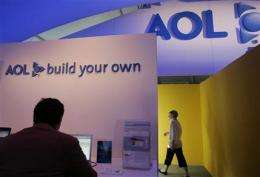AOL execs, some analysts see changes taking hold

(AP) -- AOL Inc. reported a $1 billion-plus second-quarter loss and tumbling revenue, yet the dismal-sounding numbers appear to belie a more positive reality: The troubled Internet company is actually chugging along on its long road to recovery.
AOL is in the midst of a turnaround effort under CEO Tim Armstrong, a former Google Inc. executive who is trying to shift AOL from relying on a shrinking dial-up Internet business to finding growth in online ad sales.
So far, this has not been easy. Since splitting from Time Warner Inc. in December, the company has shown few obvious signs of progress, and on the surface the second quarter may sound like more bad news.
On Wednesday, AOL reported $1.4 billion in writedowns for the declining value of its assets and the sale of social networking site Bebo. The company's advertising revenue fell even faster than it did in the first three months of the year.
Still, Armstrong remained resolute about AOL's chances for survival, saying he believes the company in the past year has "moved the needle from 'survive' to 'thrive.'"
Armstrong said that the writedown doesn't point toward problems at AOL, but rather indicates that "the patient is getting healthier."
"If you look underneath it, it's really about cleaning up what happened during the AOL-Time Warner years," Armstrong said in an interview.
Some analysts agreed.
David Joyce, an analyst at Miller Tabak & Co., called the quarter "a mix of positive and negative," and said there are "some signs of improvement starting to show through."
AOL shares rose $1.63, or 7.7 percent, to close Wednesday at $22.75. Since the spinoff, AOL shares rose as high as $29.45 in April, but it's now trading nearly 23 percent lower.
AOL bought Time Warner at the height of the dot-com boom back in 2001, hoping that Time Warner's TV and magazine content would fit with AOL's dial-up Internet business. But the rise of speedier broadband Internet connections started killing off AOL's main revenue source. After years spent trying and failing to integrate the two companies, Time Warner finally spun off AOL.
The change has not been easy, as AOL's second-quarter results make clear. The company reported a net loss of $1.06 billion, or $9.89 per share, in the April-June period, compared with net income of $90.7 million, or 86 cents per share, a year ago.
And revenue sank 26 percent to $584 million from last year's nearly $792 million - far lower than the $602 million analysts surveyed by Thomson Reuters expected, on average.
Advertising revenue fell by 27 percent to $297 million. Other companies that rely heavily on online advertising have seen more positive results: Both Google and IAC/InterActiveCorp, for example, recently reported online ad growth in the April-June period.
Armstrong said much of AOL's decline stemmed from its efforts to get rid of ad products and operations that may be contributing to its revenue but not to its earnings.
This includes the disposal of Bebo, which AOL bought for $850 million in 2008, hoping it would drive traffic to its other Web properties. It hasn't, and AOL sold it during the quarter to private investment firm Criterion Capital Partners for an undisclosed amount - most likely a fraction of what it initially paid for it.
Overall, he said, the online advertising market is recovering from last year's slump, and he expects next year to be even stronger than this one.
"I think our results are a reflection of what we're doing to make AOL a healthy company, rather than what's happening in the industry," he said.
Meanwhile, revenue from AOL's subscription dial-up Internet business fell 27 percent to $260 million. This business has steadily declined for years as consumers gravitate to speedier broadband Internet services. The business ended the quarter with 4.4 million subscribers, down 25 percent from last year. At its peak in 2002, AOL had 26.7 million subscribers.
Clayton Moran, a Benchmark Co. analyst, said that although AOL still faces plenty of challenges, it looks much better than it did a year ago.
"I think you're beginning to see through all the reshaping and reorganization of the company; you're beginning to see a little light at the end of the tunnel," he said.
©2010 The Associated Press. All rights reserved. This material may not be published, broadcast, rewritten or redistributed.


















